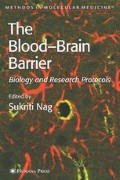Abstract
The brain requires an adequate and constant supply of glucose or alternate energy substrates to support its metabolic demands. Because of the special conditions imposed by the presence of the blood-brain barrier (BBB), specific transport mechanisms are required for the influx of water-soluble substrates. Alterations in energy substrate transport or availability has profound consequences that may result in inadequate energy supply and possible cell death. To study these transport mechanisms, quantitative methods of substrate influx and blood flow have been developed. These methods are based on a model of unidirectional tracer influx at the endothelial cell boundary from the blood during capillary transit (1).
Access this chapter
Tax calculation will be finalised at checkout
Purchases are for personal use only
References
Gjedde, A. (1983) Modulation of substrate transport to the brain. Acta Neurol. Scand. 67, 3–25.
Sage, J. I., Van Uitert, R. L., and Duffy, T. E. (1981) Simultaneous measurement of cerebral blood flow and unidirectional movement of substances across the blood-brain barrier: theory, method, and application to leucine. J. Neurochem. 36, 1731–1738.
Oldendorf, W. H. (1973) Carrier-mediated blood-brain barrier transport of short-chain monocarboxylic organic acids. Am. J. Physiol. 224,1450–1453.
Pelligrino, D. A., LaManna, J. C, Duckrow, R. B., Bryan, R. M. Jr., and Harik, S. I. (1992) Hyperglycemia and blood-brain barrier glucose transport. J. Cereb. Blood Flow Metab. 12, 887–899.
Crone, C. (1965) Facilitated transfer of glucose from blood into brain tissue. J. Physiol. 181, 103–113.
Dick, A. P., Harik, S. I., Klip, A., and Walker, D. M. (1984) Identification and characterization of the glucose transporter of the blood-brain barrier by cytochalasin B binding and immunological reactivity. Proc. Natl. Acad. Sei. U.S.A 81, 7233–7237.
LaManna, J. C, and Harik, S. I. (1985) Regional comparisons of brain glucose influx. Brain Res. 326, 299–305.
LaManna, J. C, Harrington, J. F, Vendel, L. M., Abi-Saleh, K., Lust, W. D., and Harik, S. I. (1993) Regional blood-brain lactate influx. Brain Res. 614, 164–170.
Shockley, R. P., and LaManna, J. C. (1988) Determination of rat cerebral cortical blood volume changes by capillary mean transit time analysis during hypoxia, hypercapnia and hyperventilation. Brain Res. 454, 170–178.
Crumrine, R. C, and LaManna, J. C. (1991) Regional cerebral metabolites, blood flow, plasma volume, and mean transit time in total cerebral ischemia in the rat. J. Cereb. Blood Flow Metab. 11, 272–282.
Sakurada, O., Kennedy, C, Jehle, J., Brown, J. D., Carbin, G. L., and Sokoloff, L. (1978) Measurement of local cerebral blood flow with iodo [14C] antipyrine. Am. J. Physiol. 234, H59–66.
Lincoln, B. C, Des Rosiers, C, and Brunengraber, H. (1987) Metabolism of S-3-hydroxybutyrate in the perfused rat liver. Arch. Biochem. Biophys. 259, 149–156
Lowry, O. H., and Passonneau, J. V. (1972) A Flexible System of Enzymatic Analysis. Academic Press, New York.
LaManna, J. C. and Harik, S. I. (1986) Regional studies of blood-brain barrier transport of glucose and leucine in awake and anesthetized rats. J. Cereb. Blood Flow Metab. 6, 717–723
Crone, C. (1977) Transport of solutes and water across the blood-brain barrier [proceedings]. J. Physiol. 266, 34P–35P
Riachi, N. J., LaManna, J. C, and Harik, S. I. (1989) Entry of 1-methyl-4-phenyl-1,2,3,6-tetra-hydropyridine into the rat brain. J. Pharmacol. Exp. Ther. 249, 744–748.
Pardridge, W. M., Connor, J. D., and Crawford, I. L. (1975) Permeability changes in the blood-brain barrier: Causes and consequences. CRC Crit. Rev. Toxicol. 3, 159–199.
Knudsen, G. M., Paulson, O. B., and Hertz, M. M. (1991) Kinetic analysis of the human blood-brain barrier transport of lactate and its influence by hypercapnia. J. Cereb. Blood Flow Metab. 11, 581–586.
Lear, J. L., and Kasliwal, R. K. (1991) Autoradiographic measurement of cerebral lactate transport rate constants in normal and activated conditions. J. Cereb. Blood Flow Metab. 11, 576–580.
Gjedde, A., and Crone, C. (1975) Induction processes in blood brain transfer of ketone bodies during starvation. Am. J. Physiol. 229, 1165–1169.
Harik, S. I., and LaManna, J. C. (1988) Vascular perfusion and blood-brain glucose transport in acute and chronic hyperglycemia. J. Neurochem. 51, 1924–1929.
LaManna, J. C, McCracken, K. A., and Strohl, K. P. (1989) Changes in regional cerebral blood flow and sucrose space after 3–4 weeks of hypobaric hypoxia (0.5 ATM). Adv. Exp. Med. Biol. 248, 471–477.
LaManna, J. C, Kikano, G E., and Harik, S. I. (1989) Brain blood flow and sucrose space in acute and chronic hyperglycemia. In: Neurotransmission and Cerebrovascular Function I. Elsevier, Amsterdam.
Kikano, G. E., LaManna, J. C., and Harik, S. I. (1989) Brain perfusion in acute and chronic hyperglycemia in rats. Stroke 20, 1027–1031.
De Vivo, D. C, Trifiletti, R. R., Jacobson, R. I., Ronen, G M., Behmand, R. A., and Harik, S. I. (1991) Defective glucose transport across the blood-brain barrier as a cause of persistent hypoglycorrhachia, seizures, and developmental delay. N. Engl. J. Med. 325, 703–709.
Author information
Authors and Affiliations
Editor information
Editors and Affiliations
Rights and permissions
Copyright information
© 2003 Humana Press Inc., Totowa, NJ
About this protocol
Cite this protocol
Puchowicz, M.A., Xu, K., LaManna, J.C. (2003). Single-Pass Dual-Label Indicator Method. In: Nag, S. (eds) The Blood-Brain Barrier. Methods in Molecular Medicine™, vol 89. Humana Press. https://doi.org/10.1385/1-59259-419-0:265
Download citation
DOI: https://doi.org/10.1385/1-59259-419-0:265
Publisher Name: Humana Press
Print ISBN: 978-1-58829-073-1
Online ISBN: 978-1-59259-419-1
eBook Packages: Springer Protocols

